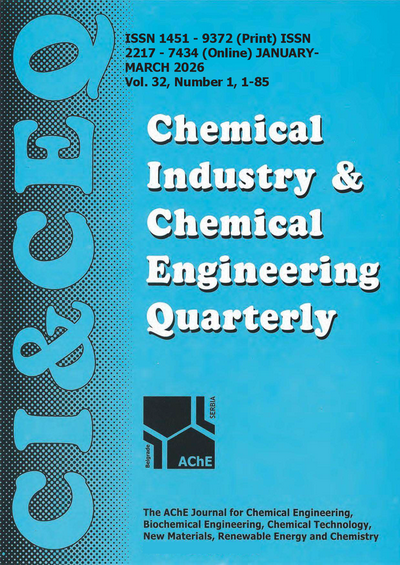INVOLVEMENT OF AMINOALKYLATED MERRIFIELD RESINS RETRACTED BY BIS(CHLORODIETHYL) ETHER IN METAL EXTRACTION
Original scientific paper
DOI:
https://doi.org/10.2298/CICEQ240814011MKeywords:
Merrifield resin, ethylenediamine, chlorodiethyl, metal extractionAbstract
Merrifield resin, a cross-linked polystyrene resin with chloromethyl functional groups, is an extremely resilient material resistant to water and environmental degradation. Our objective is to develop novel substituted polymers with functional groups capable of chelating heavy metals for depollution applications. Cross-linked polymer networks, which are predominantly insoluble and adaptable to diverse chemical environments, are invaluable for pollution management. A key area of environmental significance is the selective retention of organic contaminants for purifying polluted water sources. This work focuses on creating new chelating polymeric sorbents for metal extraction by grafting ethylenediamine (EDA) and triethylenetetramine (TETA) onto Merrifield resin, resulting in two polymers: MR-EDA and MR-TETA. These modified polymers are further reticulated with bis(chlorodiethyl) ether to produce two novel reticulated polymers, MR-TETA-BCEE and MR-EDA-BCEE.To characterize the polymers, differential thermal analysis (DTA) and infrared (IR) spectroscopy are employed. The resins are subsequently tested for their ability to extract lead (Pb²⁺) and lithium (Li⁺) ions from aqueous solutions using the solid-phase extraction (SPE) method. Conductivity and atomic absorption spectrometry (AAS) analyses demonstrate high extraction efficiencies, ranging from 50% to 85% for both Pb²⁺ and Li⁺ ions. These results demonstrate the potential of MR-EDA-BCEE and MR-TETA-BCEE as effective polymeric sorbents for environmental remediation and heavy metal removal from water.
References
1. G. Pina-Luis, G.A. Rosquete Pina, A.C. Valdés Gonzaléz, A.O. Teran, I.R. Espejel, M.E. Diaz-Garcia, React. Funct. Polym. 72 (2012) 61–68. https://doi.org/10.1016/j.reactfunctpolym.2011.10.003
2. A. Sigel, H. Sigel, R.K.O. Sigel, Springer International Publishing, Basel, Switzerland (2016),1–10DOI 10.1007/978-3-319-21756-7
3. H. Zhang, J. Hou, Y. Hu, P. Wang,R. Ou, L. Jiang, J.Z. Liu, B.D. Freeman, A.J. Hill and H. Wang, Anal. Sci. Adv. 4 (2018) 0066. https://doi.org/10.1126/sciadv. aaq0066
4. L.A. Berrueta, B. Gallo, F. Vicente, j.Chromatographia 40 (1995) 474–483. https://doi.org/10.1007/BF02269916
5. M.E. Leon-Gonzale, L.V. Perez-Arribas, J. Chromatogr. A 902 (2000) 3–16. https://doi.org/10.1016/S0021-9673(00)00942-0
6. D. Sud, Ion Exchange Technology I, Springer: Dordrecht, Holland (2012), p 376. https://doi.org/10.1007/978-94-007-4375-5_13
7. R. Slimi, R. Ben Othman, N. Sleimi, A. Ouerghui, C. Girard, Polymers 8 (2016) 187-193.https://doi.org/10.3390/polym8050187
8. M.S. Lukashova, K.N. Belikov, K.Y. Bryleva, S.G. Kharckenko, S.G. Vishnevsky, V.I. Kalchenko, Adv. Funct. Mater. 23 (2016)111-119. https://doi.org/10.15407/fm23.01.111
9. S.F. Puig, L. Alberto, V.V. Becerra, A.O. Teran, A.C. Ramírez, A.V. González, Mater. Res. Express. 11 (2019) 104-115. https://doi.org/10.1088/2053-1591/ab4470
10. M. Dardouri, F. Ammari, F. Mgananem J. Polym. Sci. 6 (2015) 782841.https://doi.org/10.1155/2015/782841
11. B. Zou, S. Zhang, P. Sun, Z. Ye, Q. Zhao, W. Zhang, L. Zhou, J. Colloid Interface Sci. Commun. 40 (2021) 100349.https://doi.org/10.1016/j.colcom.2020.100349
12. G. Duan, C. Zhanfang, H. Zhong, X. Ma, S. Wang, J. Environ. Manage. 308 (2022) 114631. https://doi.org/10.1016/j.jenvman.2022.114631
13. A.L. Villa-Reyna, M. Aguilar-Martínez, A. Ochoa-Terán, H. Santacruz-Ortega, M.A. Leyva-Peralta, J.T. Vargas-Durazo, J.C. Gálvez-Ruiz, Polymers 15 (2023) 2778. https://doi.org/10.3390/polym15132778
14. R. Qu, J. Liu, C. Sun, Y. Zhang, C. Ji, P. Yin, J. Chem. Eng. 55 (2010) 4650–4659. https://doi.org/10.1021/je100246y
15. F. Mbarki, F. Ammari, A.B.H. Amor, F. Meganem, Polymery62 (2017) 109-117. https://doi.org/10.14314/polimery.2017.109
16. A. Kadous, M.A. Didi, D. Villemin, J. Radioanal. Nucl. Chem. 284 (2010) 431–438. https://doi.org/10.1007/s10967-010-0495-7
17. F. Ammari, F. Meganem, Turk. J. Chem. 38 (2014) 638-649. https://doi.org/10.3906/kim-1306-24
18. A. Ouerghui, M. Dardouri, N. Sleimimi, A. Bel Hadj Amor, F. Ammari, C. Girard, Po-limery, 64 (1), 2019, 3-11. doi: 10.11648/j.ajpst.20190503.11
19. M. Dardouri, F. Ammari, A. Bel Hadj Amor, F. Meganem, Mater. Chem. Phys., 216, 2018, 435-445. https://doi.org/10.1016/j.matchemphys.2018.06.002
Downloads
Published
Issue
Section
License
Copyright (c) 2023 Marwa Mrabet, Adnen Mabrouki, Fayçel Ammari

This work is licensed under a Creative Commons Attribution-NonCommercial-NoDerivatives 4.0 International License.
Authors who publish with this journal agree to the following terms:
Authors retain copyright and grant the journal right of first publication with the work simultaneously licensed under a Creative Commons Attribution License that allows others to share the work with an acknowledgement of the work's authorship and initial publication in this journal.
Authors grant to the Publisher the following rights to the manuscript, including any supplemental material, and any parts, extracts or elements thereof:
- the right to reproduce and distribute the Manuscript in printed form, including print-on-demand;
- the right to produce prepublications, reprints, and special editions of the Manuscript;
- the right to translate the Manuscript into other languages;
- the right to reproduce the Manuscript using photomechanical or similar means including, but not limited to photocopy, and the right to distribute these reproductions;
- the right to reproduce and distribute the Manuscript electronically or optically on any and all data carriers or storage media – especially in machine readable/digitalized form on data carriers such as hard drive, CD-Rom, DVD, Blu-ray Disc (BD), Mini-Disk, data tape – and the right to reproduce and distribute the Article via these data carriers;
- the right to store the Manuscript in databases, including online databases, and the right of transmission of the Manuscript in all technical systems and modes;
- the right to make the Manuscript available to the public or to closed user groups on individual demand, for use on monitors or other readers (including e-books), and in printable form for the user, either via the internet, other online services, or via internal or external networks.






